Jupiter
Jupiter’s multicolored bands, dotted with ovals of white and brown (Figure 8-1), give it the appearance of a world unlike any of the terrestrial planets. Viewed even through a small telescope (see Figure 2-11b), you can also see up to four of its moons. As the high-resolution images in this chapter reveal, Jupiter is a world of breathtaking beauty.
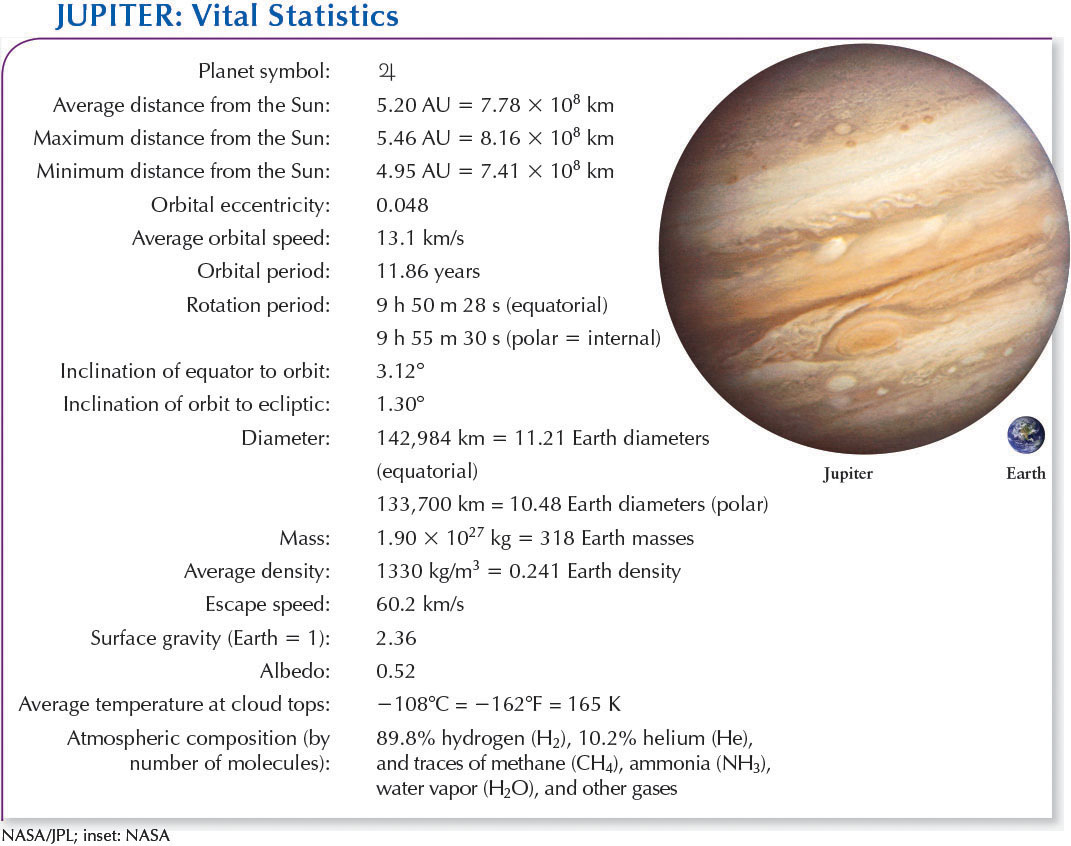
 Jupiter and Its Vital Statistics This view was sent back from Voyager 1 in 1979. Features as small as 600 km (370 mi) across can be seen in the turbulent cloud tops of this giant planet. The complex cloud motions that surround the Great Red Spot are clearly visible. Also, clouds at different latitudes have different rotation rates. The inset image of Earth shows its size relative to Jupiter.
Jupiter and Its Vital Statistics This view was sent back from Voyager 1 in 1979. Features as small as 600 km (370 mi) across can be seen in the turbulent cloud tops of this giant planet. The complex cloud motions that surround the Great Red Spot are clearly visible. Also, clouds at different latitudes have different rotation rates. The inset image of Earth shows its size relative to Jupiter.
 Jupiter is the largest planet in the solar system: More than 1300 Earths could be packed into its volume. Using the orbital periods of its moons in Kepler’s laws, astronomers have determined that Jupiter is 318 times more massive than Earth. Indeed, Jupiter has more than 2½ times as much mass as all of the other planets combined. This huge mass has created the myth that Jupiter is a failed star, meaning that it has almost enough matter to shine on its own, like the Sun, which we will study in Chapter 10. In fact, Jupiter would have to be 75 times more massive than it is to generate energy like the Sun, and therefore to be classified as a star.
Jupiter is the largest planet in the solar system: More than 1300 Earths could be packed into its volume. Using the orbital periods of its moons in Kepler’s laws, astronomers have determined that Jupiter is 318 times more massive than Earth. Indeed, Jupiter has more than 2½ times as much mass as all of the other planets combined. This huge mass has created the myth that Jupiter is a failed star, meaning that it has almost enough matter to shine on its own, like the Sun, which we will study in Chapter 10. In fact, Jupiter would have to be 75 times more massive than it is to generate energy like the Sun, and therefore to be classified as a star.
Nevertheless, Jupiter emits approximately twice as much energy as it receives from the Sun. Its extra energy comes from radioactive elements in its core and from an overall contraction amounting to less than 10 cm per century. Contraction contributes to heating because when any matter is compressed, it heats up.
8-1 Jupiter’s outer layer is a dynamic area of storms and turbulent gases
Jupiter is permanently covered with clouds (see Figure 8-1). Because it rotates about once every 10 hours—the fastest of any planet—Jupiter’s clouds are in perpetual motion and are confined to narrow bands of latitude. Even through a small telescope, you can see Jupiter’s dark, reddish bands called belts, alternating with light-colored bands called zones. The zones are white due to ammonia vapor at their tops, while the sources of the colors of the belts are still under investigation. These belts and zones are gases flowing eastward or westward, with very little north-south motion. Such winds are called a zonal flow, and why some winds flow one way and some the other is still under investigation. In contrast, winds on slower-rotating Earth wander over vast ranges of latitude (compare Figure 6-1). Wind speeds between 310 km/h (190 mph) and 645 km/h (400 mph) are typical on Jupiter.
Jupiter’s belts and zones provide a framework for turbulent swirling cloud patterns, as well as rotating storms similar in structure to hurricanes or cyclones on Earth. These storms are known as white ovals and brown ovals (Figure 8-2). The white ovals are observed to be cool clouds higher than the average clouds in Jupiter’s atmosphere. The brown ovals are warmer and lower clouds, seen through holes in the normal cloud layer. The various oval features last from hours to centuries. Computers show us how the cloud features on Jupiter would look if the planet’s atmosphere were unwrapped and laid flat like a map of Earth (Figure 8-3).
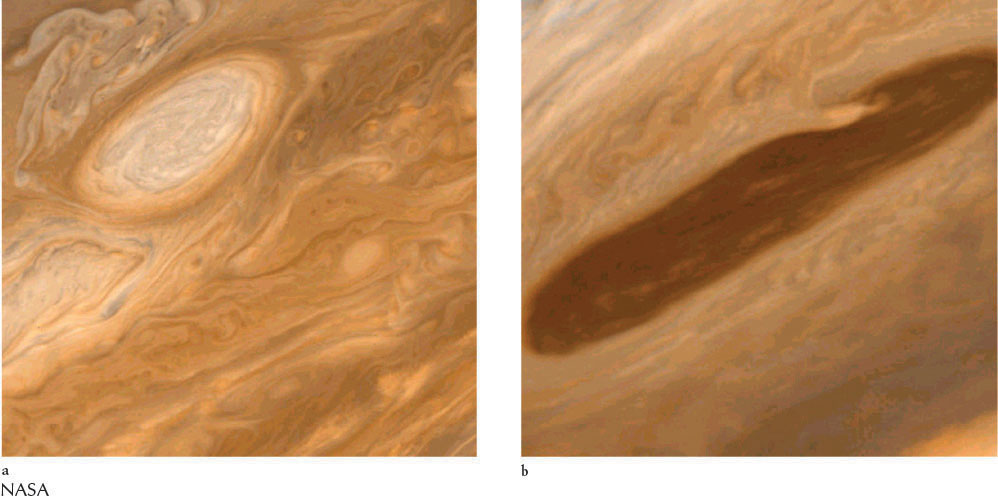
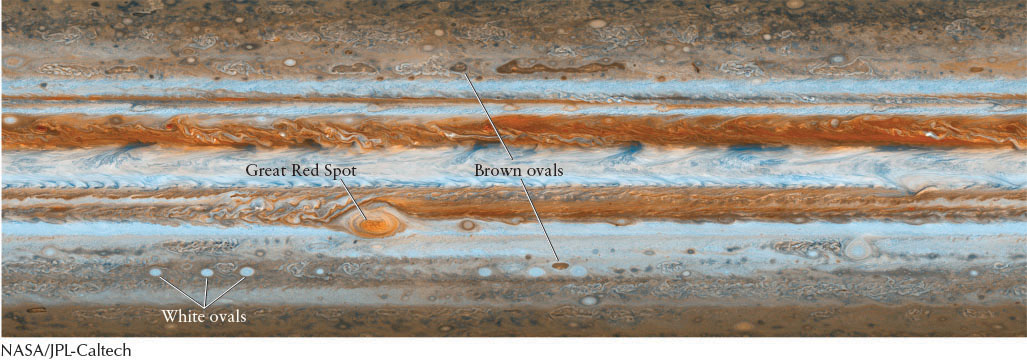
Jupiter’s most striking feature is its Great Red Spot (Figure 8-4), which is so large that it can be seen through a small telescope. This feature changes dimensions, and at present is about 25,000 km long by 12,000 km wide—large enough so that two Earths could easily fit side by side inside it today. Sometimes it expands so that three Earths would fit in it. The Great Red Spot was first observed around 1656, either by the English scientist Robert Hooke (1635–1703) or the Italian astronomer Giovanni Cassini (1625–1712). Because earlier telescopes were unlikely to have been able to see it, the Great Red Spot could well have formed long before that time.

 The Great Red Spot This image of the Great Red Spot shows the counterclockwise circulation of gas in the Great Red Spot that takes about 6 days to make one rotation. The clouds that encounter the spot are forced to pass around it, and when other oval features are near it, the entire system becomes particularly turbulent, like batter in a two-bladed blender.
The Great Red Spot This image of the Great Red Spot shows the counterclockwise circulation of gas in the Great Red Spot that takes about 6 days to make one rotation. The clouds that encounter the spot are forced to pass around it, and when other oval features are near it, the entire system becomes particularly turbulent, like batter in a two-bladed blender.
234
 The Great Red Spot is a hurricane-like or typhoonlike storm of swirling gases. Heat welling upward from inside Jupiter has maintained it for more than three and a half centuries. (Consider what life would be like for us if Earth sustained storms for such long periods!) Between 1998 and 2000, three smaller white storms on Jupiter that formed in the 1930s merged (Figure 8-5a–d), creating a larger white storm that became red in 2006 (Figure 8-5e inset). Called Red Spot Jr. (technically named Oval BA), it is similar to, but somewhat smaller than, the Great Red Spot and located at nearly the same latitude (Figure 8-5e). As with the Great Red Spot, the cause of the red color is still being studied.
The Great Red Spot is a hurricane-like or typhoonlike storm of swirling gases. Heat welling upward from inside Jupiter has maintained it for more than three and a half centuries. (Consider what life would be like for us if Earth sustained storms for such long periods!) Between 1998 and 2000, three smaller white storms on Jupiter that formed in the 1930s merged (Figure 8-5a–d), creating a larger white storm that became red in 2006 (Figure 8-5e inset). Called Red Spot Jr. (technically named Oval BA), it is similar to, but somewhat smaller than, the Great Red Spot and located at nearly the same latitude (Figure 8-5e). As with the Great Red Spot, the cause of the red color is still being studied.

In 1690, Cassini noticed that the speeds of Jupiter’s clouds vary with latitude, an effect called differential rotation. Near the poles, the rotation period of Jupiter’s atmosphere, 9 h 55 min 30 s, is 5 min longer than at the equator. Furthermore, clouds at different latitudes circulate in opposite directions—some eastward, some westward. At their boundaries, the clouds rub against each other, creating beautiful swirling patterns (see Figures 8-2, 8-4, and 8-5). The interactions of clouds at different latitudes also help provide stability for storms like the Great Red Spot.
Jupiter’s rapid rotation causes its equatorial radius to be 9284 km (5770 mi) greater than its polar radius. All such rotating worlds, wider at the equator than the poles, are said to be oblate.
 Astronomers first determined Jupiter’s overall chemical composition from its average density—only 1330 kg/m3. Recall from Section 5-10 that average density is mass divided by volume. We determine Jupiter’s mass using Kepler’s third law and the orbital periods of its moons, while the trigonometry of Jupiter’s distance from Earth and angular size in our sky reveal its diameter and hence its volume. This low density implies that Jupiter is composed of primarily the lightweight elements hydrogen and helium surrounding a relatively small central volume thousands of kilometers below its cloud tops containing water, metal, and rock. The planet has no solid continents, islands, or water oceans on its surface. Because their primary elements are hydrogen and helium, Jupiter and Saturn are called gas giants.
Astronomers first determined Jupiter’s overall chemical composition from its average density—only 1330 kg/m3. Recall from Section 5-10 that average density is mass divided by volume. We determine Jupiter’s mass using Kepler’s third law and the orbital periods of its moons, while the trigonometry of Jupiter’s distance from Earth and angular size in our sky reveal its diameter and hence its volume. This low density implies that Jupiter is composed of primarily the lightweight elements hydrogen and helium surrounding a relatively small central volume thousands of kilometers below its cloud tops containing water, metal, and rock. The planet has no solid continents, islands, or water oceans on its surface. Because their primary elements are hydrogen and helium, Jupiter and Saturn are called gas giants.
235
Spectra from Earth-based telescopes and from the Galileo probe sent into Jupiter’s upper atmosphere in 1995 give more detail about the chemistry of this giant world’s upper level. About 86% of its atoms are hydrogen and 13% are helium. The remainder consists of molecular compounds, such as methane (CH4), ammonia (NH3), and water vapor (H2O). Keeping in mind that different elements have different masses, we can convert these percentages of atoms into the masses of various substances in Jupiter’s atmosphere: 75% hydrogen, 24% helium, and 1% other substances. Because the interior contains heavier elements than the surface, the overall mass distribution in Jupiter has been calculated to be 71% hydrogen, 24% helium, and 5% heavier elements.
Observations from spacecraft visiting Jupiter and its moons, combined with the scientific model of Jupiter’s atmosphere developed to explain the observations of Jupiter’s clouds and chemistry, indicate that it has three major cloud layers (Figure 8-6a). The uppermost Jovian cloud layer is composed of crystals of frozen ammonia. These crystals and the frozen water in Jupiter’s clouds are white, so what chemicals create the subtle tones of brown, red, and orange? The answer is as yet unknown. Some scientists think that sulfur compounds, which can assume many different colors, depending on their temperature, play an important role; others think that phosphorus is involved, especially in the Great Red Spot. The middle cloud layer is primarily ammonium hydrosulfide, and the bottom cloud layer is mostly composed of water vapor.

Margin Question 8-1
Question
What are the two most common elements in Jupiter’s upper layers?
The descent of a probe from the Galileo spacecraft into Jupiter’s atmosphere in 1995 revealed wind speeds of up to 600 km/h (375 mi/h), higher-than-expected air density and temperature, and lower-than-expected concentrations of water, helium, neon, carbon, oxygen, and sulfur. These seemingly abnormal observations probably occurred because the probe descended into a particularly arid region of the atmosphere called a hot spot, akin to the air over a desert on Earth.
236
Below its cloud layer, Jupiter’s mantle is entirely liquid. Here on Earth, the distinction between the gaseous air and the liquid oceans is very clear—jump off a diving board and you know when you hit the water. However, the conditions on Jupiter under which hydrogen liquefies are different from anything we normally experience. Solid, liquid, and gas are called phases of matter. Going from one phase to another in everyday life is called a phase transition. Under conditions of extreme pressure and temperature, phase transitions do not occur. As a result, on Jupiter there is no definite boundary between the planet’s gaseous atmosphere and its liquid mantle. The hydrogen gradually gets denser until 1000 km below the cloud tops the pressure is high enough for the hydrogen to be what we would consider a liquid.
In introducing the solar system, we noted that the young planets heated up as they coalesced. After they formed, radioactive elements continued to heat their interiors. On Earth, this heat leaks out of the surface through volcanoes and other vents. Jupiter loses heat through its clouds everywhere because, unlike Earth, it has no surface landmasses to block the heat loss.
Still heated from deep within Jupiter, blobs of liquid hydrogen and helium move upward inside the planet. When these blobs reach the cloud tops, they release their heat and descend back into the interior. (The same process, convection, drives the motion of Earth’s mantle and its tectonic plates, as well as liquid simmering on a stove; see Figure 6-10.) Jupiter’s rapid, differential rotation draws the convective gases into bands of winds moving eastward and westward at different speeds around the planet.
Astronomers believe that Jupiter’s belts and zones result from the combined actions of the planet’s convection and rapid differential rotation. The light-colored zones are regions of hotter, rising gas, while the dark belts are regions of cooler, descending gas (Figure 8-7). Intriguingly, high-resolution observations by the passing Cassini spacecraft on its way to Saturn revealed numerous white clouds that are too small to be seen from Earth rising in the dark belts of Jupiter. Astronomers are working to understand these newly discovered features.
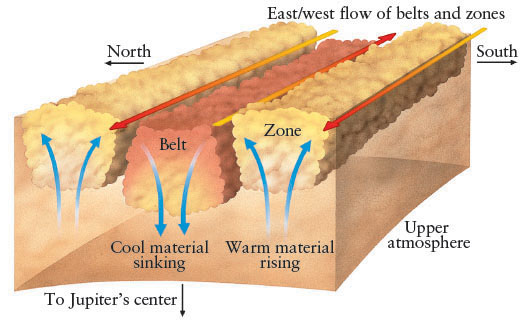
8-2 Jupiter’s interior has four distinct regions
Descending below Jupiter’s clouds, we first encounter liquid molecular hydrogen and helium. As in Earth’s oceans, the pressure in this fluid increases with depth. The gravitational force created by Jupiter’s enormous mass compresses and heats its interior so much that 20,000 km (12,500 mi) below the cloud tops, the pressure is 3 million atm. Below this depth, the pressure is high enough to transform hydrogen into liquid metallic hydrogen (Figure 8-8). In this state, hydrogen acts like a metal (similar to the copper wiring in a house) in its ability to conduct electricity and heat. Electric currents that run through this rotating, metallic region of Jupiter generate a powerful planetary magnetic field (Figure 8-9). At the cloud level of Jupiter, this field is 14 times stronger per square meter than Earth’s field is at our planet’s surface. Jupiter’s magnetic field has a region, like Earth’s Van Allen belts, where charged particles are stored (depicted in orange in Figure 8-9a) and its tail (called the magnetotail) streams outward as far as Saturn, over 700 million km away.
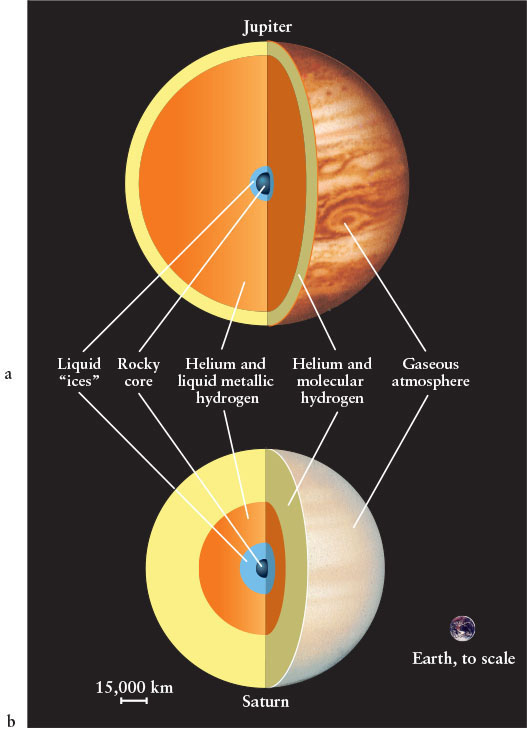
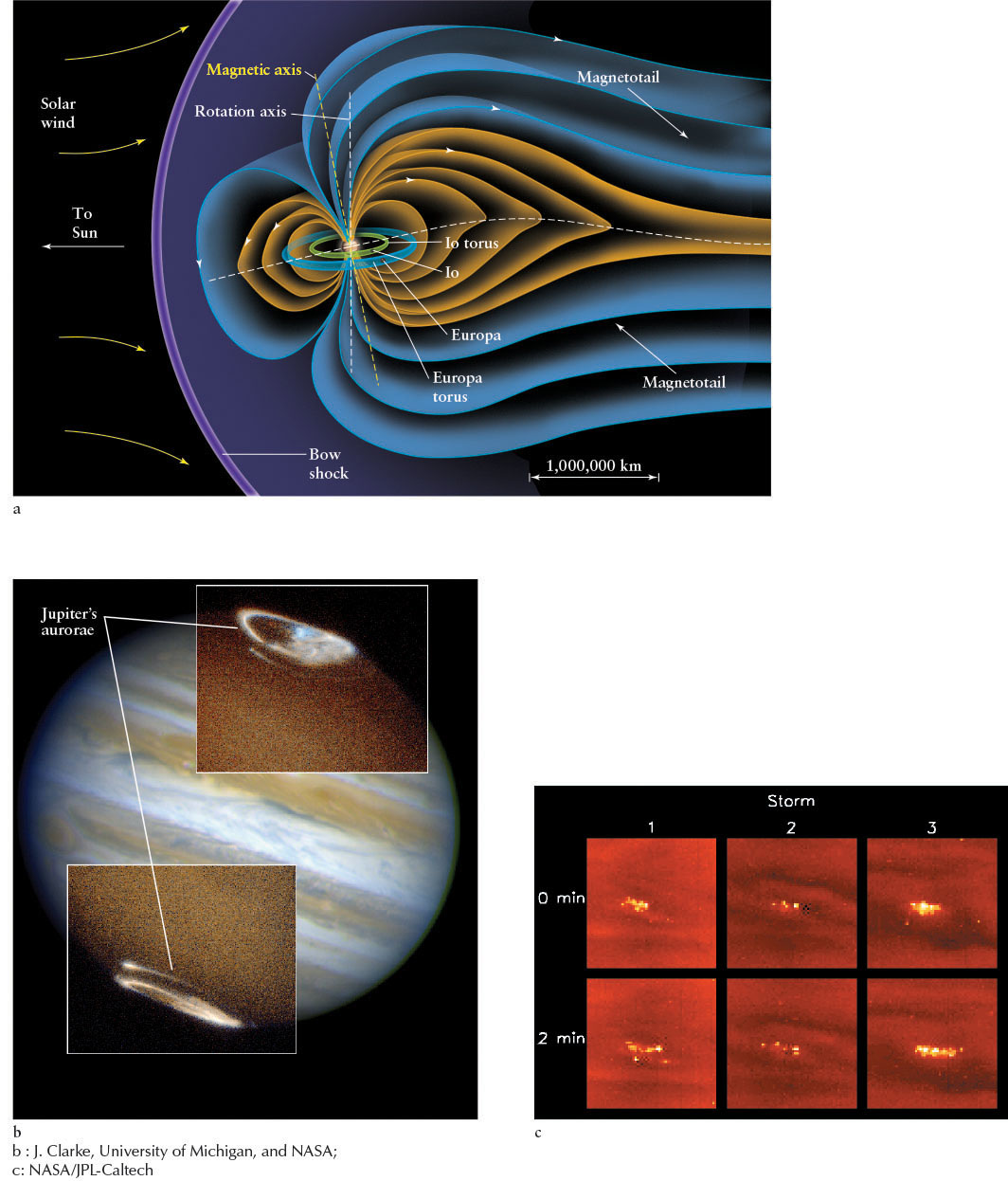
237
238
For Earth-based astronomers, the first evidence of Jupiter’s magnetosphere was a hiss of radio static, which varies cyclically over a period of 9 h 55 min 30 s, the planet’s internal rotation rate. In recent years, astronomers have also been able to observe from Earth (and from space) permanent aurorae surrounding Jupiter’s poles (Figure 8-9b). These aurorae have their distinctive ring shapes as a result of the glowing gases being trapped by the planet’s magnetic field. Beginning with the two Pioneer and two Voyager spacecraft that journeyed past Jupiter in the 1970s, and continuing with the recent Galileo and Cassini spacecraft, the awesome dimensions of Jupiter’s magnetosphere have been revealed: It is nearly 30 million km across and envelops the orbits of many of its moons. If Jupiter’s magnetosphere were visible from Earth, it would cover an area of the sky 16 times larger than the Moon as seen from here.
Based on the Nice theory of giant planet formation (Section 5-3), it appears that a terrestrial (rock and metal) protoplanet formed out beyond the snow line and attracted hydrogen and helium to form its outer layers. This terrestrial matter is now Jupiter’s core. This core is only 4% of Jupiter’s mass, which still amounts to nearly 13 times the mass of the entire Earth. Water, carbon dioxide, methane, and ammonia are likely to have existed as ice in Jupiter’s terrestrial protoplanet, and they were also attracted onto the young and growing planet. When astronomers talk in general terms about “ice,” they are referring to any or all of these four compounds.
The tremendous crushing weight of the bulk of Jupiter above the core—equal to the mass of 305 Earths—compresses the terrestrial core down to a sphere only 10,000 km in radius (see Figure 8-8). By comparison, Earth’s diameter is 12,756 km. The pressure at Jupiter’s very center is calculated to be about 70 million atm, and the temperature there is about 25,000 K, nearly 4 times hotter than the surface of the Sun. Recent calculations using sophisticated computer simulations of Jupiter’s interior have discovered that the iron in its core is likely dissolving as it interacts with the surrounding liquid metallic hydrogen. This result is going to be explored in 2016 when the NASA spacecraft Juno reaches Jupiter. This implies, of course, that Jupiter’s core is shrinking. The interior of Jupiter is summarized in Figure 8-8a.
Interestingly, Jupiter gives off about twice as much energy as it receives from the Sun. Emitting this extra energy causes the planet to cool ever so slightly. As a planet cools, its gravity causes it to contract. Therefore, Jupiter is presently shrinking about a centimeter per decade. This process of cooling and contracting, called the Kelvin-Helmholtz mechanism, was proposed by Lord Kelvin (1824–1907) and Hermann von Helmholtz (1821–1894).
8-3 Impacts provide probes into Jupiter’s atmosphere
On July 7, 1992, a comet nucleus (a clump of rock and ice a few kilometers across, discussed in Chapter 9) passed so close to Jupiter that the planet’s gravitational tidal force ripped it into at least 21 pieces. The debris from this comet was first observed in March 1993 by comet hunters Gene and Carolyn Shoemaker and David Levy. (Because it was the ninth comet they had found together, it was named Shoemaker-Levy 9 in their honor.) Shoemaker-Levy 9 was an unusual comet that actually orbited Jupiter, rather than just orbiting the Sun. Calculations of the comet’s orbit showed that the pieces (Figure 8-10a) would return to strike Jupiter between July 16 and July 22, 1994.
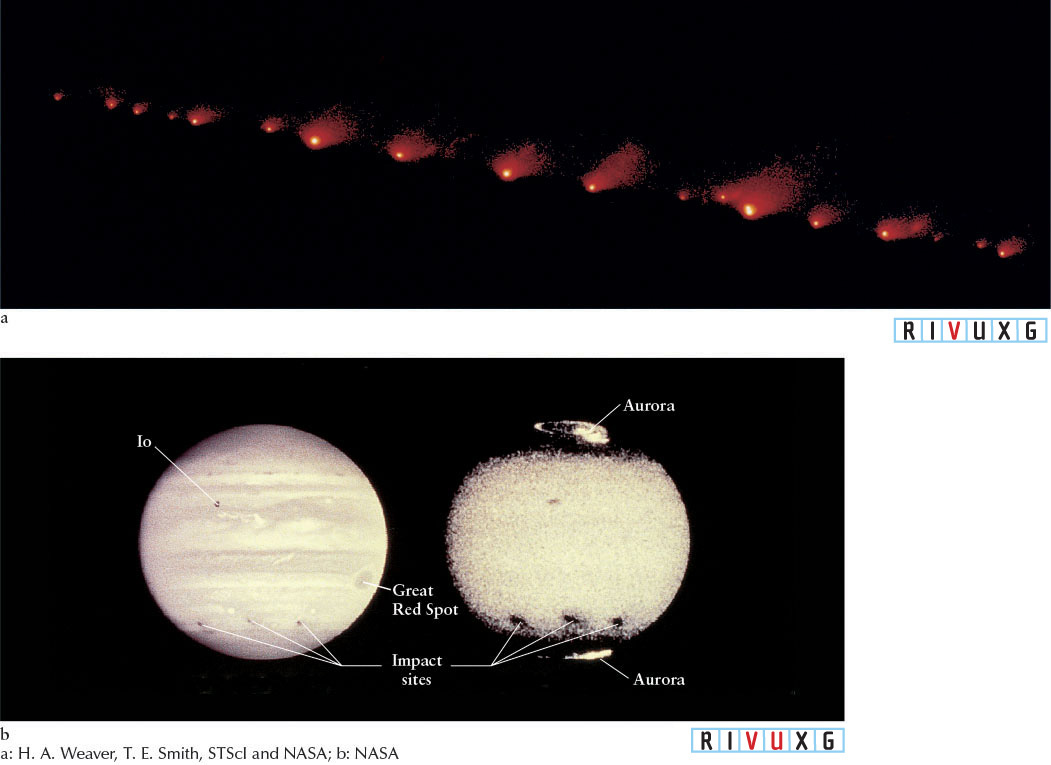
Recall from Chapter 5 that impacts were extremely common in the first 800 million years of the solar system’s existence. From more recent times, two chains of impact craters have been discovered on Earth, consistent with pieces of comets having hit our planet within the past 300 million years. However, it is very uncommon for pieces of space debris as large as several kilometers in diameter to collide with planets today. Therefore, the discovery that Shoemaker-Levy 9 would hit Jupiter created great excitement in the astronomical community. Seeing how a planet and a comet respond to such an impact would allow astronomers to deduce information about the planet’s atmosphere and interior as well as about the striking body’s properties.
The impacts occurred as predicted, with most of Earth’s major telescopes—as well as those on several spacecraft—watching closely (Figure 8-10b). At least 20 fragments from Shoemaker-Levy 9 struck Jupiter, and 15 of them had detectable impact sites. The impacts resulted in fireballs some 10 km in diameter with temperatures of 7500 K, which is hotter than the surface of the Sun. Indeed, the largest comet fragment gave off as much energy as 600 million megatons of TNT, far more than the combined energy that could be released by all the nuclear weapons currently stockpiled on Earth. Impacts were followed by crescent-shaped ejecta that contained a variety of chemical compounds. Ripples or waves spread out from the impact sites through Jupiter’s clouds in splotches that lasted for months.
The observations suggested that the pieces of comet did not penetrate very far into Jupiter’s upper cloud layer. This fact, in turn, supports the belief that the pieces were not much larger than a kilometer in diameter. The ejecta from each impact included a dark plume that rose high into Jupiter’s atmosphere. The darkness was apparently due to carbon compounds that vaporized from the cometary bodies. Also detected from the comet collisions were water, sulfur compounds, silicon, magnesium, and iron.
On July 19, 2009, an amateur astronomer discovered a new dark patch near Jupiter’s south pole. Further observations revealed that this feature was created by another impact that had occurred about 4 hours before it was actually observed. Unlike the impact of 1994, this collision occurred when a small asteroid, about 0.5 km in diameter and composed of rock and metal, struck Jupiter. Astronomers were able to distinguish between the two causes (comet versus asteroid) by noting that gases and dust drifting along with the pieces of comet that struck Jupiter created halos around the impact sites, while the asteroid, lacking the surrounding gas and dust as it slammed into Jupiter, had no halo. Based on the 1994 and 2009 impacts, it appears that Jupiter is struck by pieces of debris 0.5 to 1 km in diameter every 10 to 15 years.
239